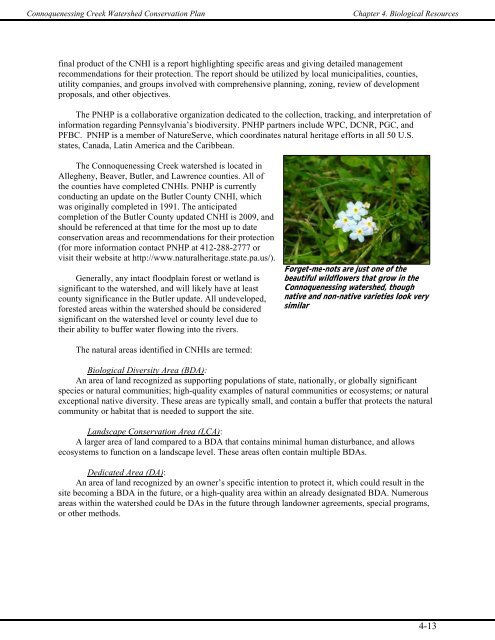CHAPTER 4 - Western Pennsylvania Conservancy
CHAPTER 4 - Western Pennsylvania Conservancy
CHAPTER 4 - Western Pennsylvania Conservancy
Create successful ePaper yourself
Turn your PDF publications into a flip-book with our unique Google optimized e-Paper software.
Connoquenessing Creek Watershed Conservation Plan<br />
Chapter 4. Biological Resources<br />
final product of the CNHI is a report highlighting specific areas and giving detailed management<br />
recommendations for their protection. The report should be utilized by local municipalities, counties,<br />
utility companies, and groups involved with comprehensive planning, zoning, review of development<br />
proposals, and other objectives.<br />
The PNHP is a collaborative organization dedicated to the collection, tracking, and interpretation of<br />
information regarding <strong>Pennsylvania</strong>’s biodiversity. PNHP partners include WPC, DCNR, PGC, and<br />
PFBC. PNHP is a member of NatureServe, which coordinates natural heritage efforts in all 50 U.S.<br />
states, Canada, Latin America and the Caribbean.<br />
The Connoquenessing Creek watershed is located in<br />
Allegheny, Beaver, Butler, and Lawrence counties. All of<br />
the counties have completed CNHIs. PNHP is currently<br />
conducting an update on the Butler County CNHI, which<br />
was originally completed in 1991. The anticipated<br />
completion of the Butler County updated CNHI is 2009, and<br />
should be referenced at that time for the most up to date<br />
conservation areas and recommendations for their protection<br />
(for more information contact PNHP at 412-288-2777 or<br />
visit their website at http://www.naturalheritage.state.pa.us/).<br />
Generally, any intact floodplain forest or wetland is<br />
significant to the watershed, and will likely have at least<br />
county significance in the Butler update. All undeveloped,<br />
forested areas within the watershed should be considered<br />
significant on the watershed level or county level due to<br />
their ability to buffer water flowing into the rivers.<br />
Forget-me-nots are just one of the<br />
beautiful wildflowers that grow in the<br />
Connoquenessing watershed, though<br />
native and non-native varieties look very<br />
similar<br />
The natural areas identified in CNHIs are termed:<br />
Biological Diversity Area (BDA):<br />
An area of land recognized as supporting populations of state, nationally, or globally significant<br />
species or natural communities; high-quality examples of natural communities or ecosystems; or natural<br />
exceptional native diversity. These areas are typically small, and contain a buffer that protects the natural<br />
community or habitat that is needed to support the site.<br />
Landscape Conservation Area (LCA):<br />
A larger area of land compared to a BDA that contains minimal human disturbance, and allows<br />
ecosystems to function on a landscape level. These areas often contain multiple BDAs.<br />
Dedicated Area (DA):<br />
An area of land recognized by an owner’s specific intention to protect it, which could result in the<br />
site becoming a BDA in the future, or a high-quality area within an already designated BDA. Numerous<br />
areas within the watershed could be DAs in the future through landowner agreements, special programs,<br />
or other methods.<br />
4-13














